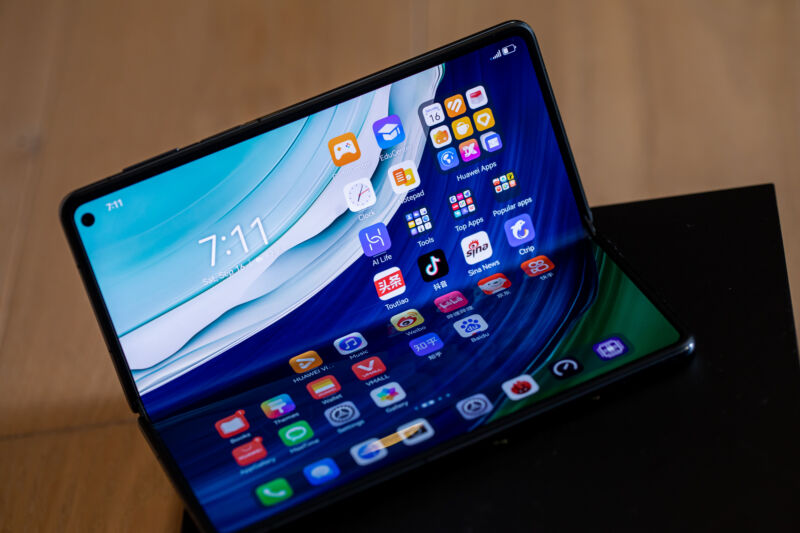Phoning it in —
Foldables are barely 1% of the market, but that’s not stopping anyone but Apple.
Tim Bradshaw, Financial Times
– Dec 31, 2023 4:26 am UTC

Enlarge / A Huawei Technologies Co. Mate X5 smartphone arranged in Hong Kong, China, on Saturday, Sept. 16, 2023.
Every large smartphone maker except Apple is betting that “foldable” phones will help revive a lacklustre mobile market, despite the devices still largely failing to attract mainstream consumers.
Foldables, which have a screen that opens like a book or compact mirror, barely exceed a 1 per cent market share of all smartphones sold globally almost five years after they were first introduced.
But Samsung has doubled down on the product, investing heavily in marketing this year. In July, the Korean group released its 5G Galaxy Z series.
The world’s largest smartphone manufacturer points to estimates from Counterpoint Research that foldable devices may surpass a third of all smartphones costing more than $600 by 2027.
“We will continue to position our foldables as a key engine for our flagship growth with the clear differentiation, experience and flexibility these devices have to offer,” said Samsung.
Other handset makers such as Motorola, China’s Huawei and its spin-off Honor are also pinning their hopes on the product helping to revive a market that suffered its worst year for more than a decade.
“This is the year people [in the industry] really dived in,” said Ben Wood, an analyst at CCS Insight. “Everybody now is betting on this, except Apple.”
The iPhone-maker has yet to show any interest in the category, though patent filings suggest it may one day introduce an iPad that folds in half. Every other big smartphone maker has followed Samsung into the market, including Google’s Pixel Fold and Chinese alternatives from Huawei, Oppo and Xiaomi.
“We believe foldables are the future of smartphone devices, just like electric cars were to the auto industry,” said Bond Zhang, UK chief executive of Honor. “We’re approaching a crucial tipping point where foldables may soon become mainstream.”
But market data shows foldables are still far from mainstream. Counterpoint Research estimates about 16 million foldable phones will be sold this year, just 1.3 percent of the 1.2 billion smartphone market total. Analysts say consumers are deterred by concerns about price, reliability and utility.
“I do wonder if there are too many products chasing too little market share at the moment,” Wood said.
Though the numbers are small in the context of the overall smartphone market, foldables are starting to gain a more meaningful share of the premium segment in certain markets, including the US and China.
The high price point of foldable phones fits with a broader pattern of polarisation in the market between premium devices, where Apple dominates, and lower-cost handsets.
Foldable phones’ premium prices are helping manufacturers offset sluggish sales of their cheaper devices. In the US, Samsung’s Z Fold 5 costs upwards of $1,800, while Honor’s Magic VS2 starts at Rmb6,999 ($979) in China.
Persuading more consumers to pay those prices has been a challenge, with many worried about the durability of their flexible screens and mechanical hinges.
Runar Bjørhovde, an analyst at Canalys, said return rates of foldables are 5-10 percent, far higher than traditional smartphones and a deterrent to repeat purchases. “It’s one thing to bring people to the [foldable] segment,” he said. “It’s another to get them to stay.”
However, Chinese manufacturers such as Honor and Huawei have found their home market more open to foldables than elsewhere. Sales of the devices in the third quarter of 2023 more than doubled over the same period last year, according to Counterpoint.
Samsung dominates the global market, with a 73 per cent share of foldables in the quarter, according to Canalys.
“Foldables have become the way to get some excitement back in smartphones,” said Carolina Milanesi, an analyst at Creative Strategies. “There’s no innovation otherwise.”
© 2023 The Financial Times Ltd. All rights reserved. Not to be redistributed, copied, or modified in any way.
>>> Read full article>>>
Copyright for syndicated content belongs to the linked Source : Ars Technica – https://arstechnica.com/?p=1993084































